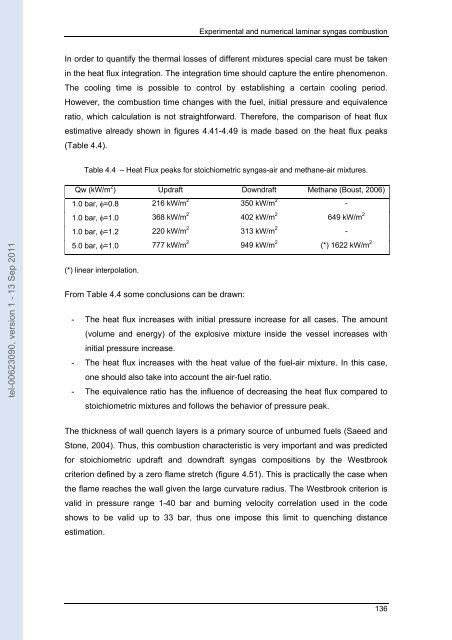Etude de la combustion de gaz de synthèse issus d'un processus de ...
Etude de la combustion de gaz de synthèse issus d'un processus de ...
Etude de la combustion de gaz de synthèse issus d'un processus de ...
You also want an ePaper? Increase the reach of your titles
YUMPU automatically turns print PDFs into web optimized ePapers that Google loves.
Experimental and numerical <strong>la</strong>minar syngas <strong>combustion</strong><br />
In or<strong>de</strong>r to quantify the thermal losses of different mixtures special care must be taken<br />
in the heat flux integration. The integration time should capture the entire phenomenon.<br />
The cooling time is possible to control by establishing a certain cooling period.<br />
However, the <strong>combustion</strong> time changes with the fuel, initial pressure and equivalence<br />
ratio, which calcu<strong>la</strong>tion is not straightforward. Therefore, the comparison of heat flux<br />
estimative already shown in figures 4.41-4.49 is ma<strong>de</strong> based on the heat flux peaks<br />
(Table 4.4).<br />
Table 4.4 – Heat Flux peaks for stoichiometric syngas-air and methane-air mixtures.<br />
tel-00623090, version 1 - 13 Sep 2011<br />
Qw (kW/m 2 ) Updraft Downdraft Methane (Boust, 2006)<br />
1.0 bar, φ=0.8 216 kW/m 2 350 kW/m 2 -<br />
1.0 bar, φ=1.0 368 kW/m 2 402 kW/m 2 649 kW/m 2<br />
1.0 bar, φ=1.2 220 kW/m 2 313 kW/m 2 -<br />
5.0 bar, φ=1.0 777 kW/m 2 949 kW/m 2 (*) 1622 kW/m 2<br />
(*) linear interpo<strong>la</strong>tion.<br />
From Table 4.4 some conclusions can be drawn:<br />
- The heat flux increases with initial pressure increase for all cases. The amount<br />
(volume and energy) of the explosive mixture insi<strong>de</strong> the vessel increases with<br />
initial pressure increase.<br />
- The heat flux increases with the heat value of the fuel-air mixture. In this case,<br />
one should also take into account the air-fuel ratio.<br />
- The equivalence ratio has the influence of <strong>de</strong>creasing the heat flux compared to<br />
stoichiometric mixtures and follows the behavior of pressure peak.<br />
The thickness of wall quench <strong>la</strong>yers is a primary source of unburned fuels (Saeed and<br />
Stone, 2004). Thus, this <strong>combustion</strong> characteristic is very important and was predicted<br />
for stoichiometric updraft and downdraft syngas compositions by the Westbrook<br />
criterion <strong>de</strong>fined by a zero f<strong>la</strong>me stretch (figure 4.51). This is practically the case when<br />
the f<strong>la</strong>me reaches the wall given the <strong>la</strong>rge curvature radius. The Westbrook criterion is<br />
valid in pressure range 1-40 bar and burning velocity corre<strong>la</strong>tion used in the co<strong>de</strong><br />
shows to be valid up to 33 bar, thus one impose this limit to quenching distance<br />
estimation.<br />
136

















